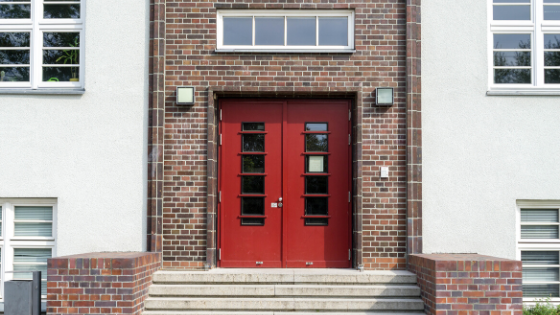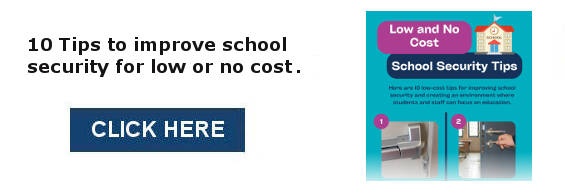By Keith Fentress and Mike Jones (Major Security Consulting and Design, LLC)
In performing a recent school security assessment, we sat down with the principal to chat, which is a routine part of our process. As we conversed about security needs, threat assessments, and related topics, we noticed a group of ordinary looking rocks on a shelf in his office. The principal explained that these rocks were found around the school and had been used to prop open doors. He had found so many that he decided to make a collection.
As we walked around the school performing our assessment, we found more rocks and blocks of wood near exterior doorways. From what we could tell during our assessment, the door props were used by the teachers, not the students. As we observed this, it became clear that the staff at the school were more focused on convenience than security. Open exterior doors represent one of the most common, and perhaps greatest, security risks in schools.
We recently attended a seminar on Protecting America’s Schools, an excellent program run by the U.S. Secret Service. The seminar highlighted the findings of a recent study on school violence. The presenters described some of the shooting events. One that stood out was a male student who came to school with the intent to inflict harm on a targeted teacher. He found his way into the school through a back door that was propped open. Upon entering the school, he shot and killed another student who recognized him.
Open exterior doors are a critical security risk and one that every school can and should address immediately. School security is a mix of physical security, technology, and policies. How each of these areas applies to exterior doors will be addressed below.
Physical Security
Having solid steel doors with sturdy latching and locking hardware is a key component of school security. Ideally, doors with glass, common at school entrances, should be treated with bullet-resistant glazing and a one-way film that allows views out from the school but prohibits views from the exterior.
If the doors have hinges on the outside, the hinges should have tamper-resistant pins that are not removable. This will prevent someone from breaching the exterior door by removing the hinge pins.
The door handles should be the type that cannot be chained together from the outside or have an object placed through handles to prevent them from opening. As an alternative, exterior doors can have recessed handles that provide a grip to open the door but cannot be chained or braced, yet are still accessible per the Americans with Disabilities Act (ADA).The door latch and closer should also be checked regularly. It is surprising the number of exterior doors we have found that can be slowly closed and will shut without latching. There is a lot of wear and tear on school doors, but most latching difficulties can be resolved with routine maintenance.
Any exterior solid doors without glass should have a viewfinder so that someone can see out before opening the door. The viewfinder should not be a peephole, like the ones routinely found in hotels, but should show an external view without having to lean directly against the door and squint through a hole that provides a distorted image.
Door Technology
The number one technology we would recommend for schools is door position switches. These switches are built into door frames and connect with a sensor that detects whether the door is closed and properly latched.
We recommend door position switches on all external doors so that they can routinely be monitored by school administration and/or security personnel. Such systems can display on a computer monitor, allowing someone to quickly view whether all exterior doors are properly latched. Doors can be set up to automatically send an alert if they are opened during specific time frames, such as while school is in session. Patterns of door opening should be investigated – it may be a teacher who routinely takes students outside for activities or it could be someone propping the door open for a friend, or students sneaking outside. Door position switches can be a vital part of keeping a building secure and preventing unwanted activities.
Security Policies
Regardless of the type of exterior doors on your school or whether you have door position switches, keeping your external doors closed and latched can be accomplished right now. It should be a primary duty of School Security Officers (SSOs) to routinely ensure that all exterior doors are properly closed. It is recommended that this check happen at least three times a day – once school is in session, after lunch periods, and in the late afternoon.
Many schools do not have SSOs, so this responsibility must be taken on by maintenance staff and/or other school personnel. Some schools establish zones with teachers being responsible to routinely check doors in their respective zones. In our opinion, it is best to have SSOs perform this duty but schools should make do with available resources.
Perhaps a more difficult issue to address is the cultural issue of propping doors open. Students open doors for numerous reasons, both good and questionable. Some schools send a clear message by disciplining students with a short suspension for letting someone from the outside into the school through an unauthorized door.
However, it is a more difficult issue to reprimand teachers and staff who prop open doors. For practical reasons, the propping of doors happens all the time. Teachers take their students out to the playground and prop doors so they can easily get back in. Maintenance workers prop doors open because they would like convenient access while carrying equipment in an out of the facility. However, such instances breach the security of the school and place students and staff at risk. At a minimum, open doors should be fully supervised as it is impractical to expect that a door will never be propped or held open. The school administration should send a clear message as to why school doors should be properly closed and latched. Verbal warnings and reprimand letters should go to staff who do not follow this policy.
This may seem trivial to staff who believe that nothing will ever happen in their school. But there are many schools around the country with horrific tragedies that also believed it wouldn’t happen to them. Fumbling with keys and access cards may seem like a hassle in the moment but may save lives. It is important that staff view door security with this higher purpose in mind.
At the Secret Service seminar, we learned that there is no single profile for a student who becomes an active shooter or a school that is likely to have any kind of active shooting event. An active shooter incident can happen anywhere. By ensuring that external doors are locked, we take a critical step in protecting a school and every one of its occupants.






-1.jpg)
.jpg)
.jpg)
.jpg)
-2.jpg)
.jpg)


.jpg)
.jpg)
.jpg)
.jpg)
.jpg)

